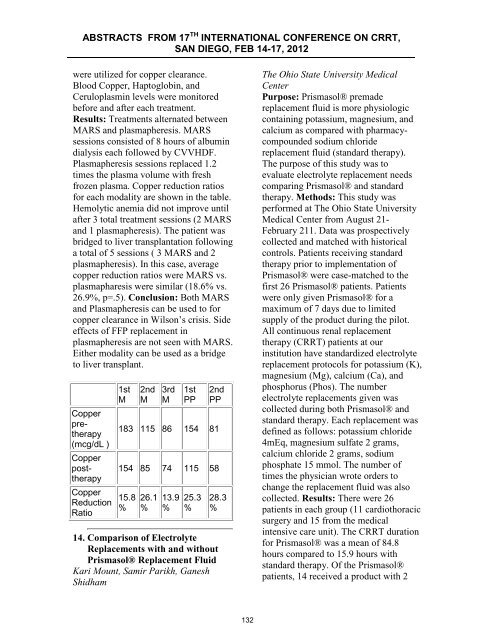ABSTRACTS from 16th International COnference on ... - CRRT Online
ABSTRACTS from 16th International COnference on ... - CRRT Online
ABSTRACTS from 16th International COnference on ... - CRRT Online
Create successful ePaper yourself
Turn your PDF publications into a flip-book with our unique Google optimized e-Paper software.
<str<strong>on</strong>g>ABSTRACTS</str<strong>on</strong>g> FROM 17 TH INTERNATIONAL CONFERENCE ON <strong>CRRT</strong>,<br />
SAN DIEGO, FEB 14-17, 2012<br />
were utilized for copper clearance.<br />
Blood Copper, Haptoglobin, and<br />
Ceruloplasmin levels were m<strong>on</strong>itored<br />
before and after each treatment.<br />
Results: Treatments alternated between<br />
MARS and plasmapheresis. MARS<br />
sessi<strong>on</strong>s c<strong>on</strong>sisted of 8 hours of albumin<br />
dialysis each followed by CVVHDF.<br />
Plasmapheresis sessi<strong>on</strong>s replaced 1.2<br />
times the plasma volume with fresh<br />
frozen plasma. Copper reducti<strong>on</strong> ratios<br />
for each modality are shown in the table.<br />
Hemolytic anemia did not improve until<br />
after 3 total treatment sessi<strong>on</strong>s (2 MARS<br />
and 1 plasmapheresis). The patient was<br />
bridged to liver transplantati<strong>on</strong> following<br />
a total of 5 sessi<strong>on</strong>s ( 3 MARS and 2<br />
plasmapheresis). In this case, average<br />
copper reducti<strong>on</strong> ratios were MARS vs.<br />
plasmapharesis were similar (18.6% vs.<br />
26.9%, p=.5). C<strong>on</strong>clusi<strong>on</strong>: Both MARS<br />
and Plasmapheresis can be used to for<br />
copper clearance in Wils<strong>on</strong>’s crisis. Side<br />
effects of FFP replacement in<br />
plasmapheresis are not seen with MARS.<br />
Either modality can be used as a bridge<br />
to liver transplant.<br />
Copper<br />
pretherapy<br />
(mcg/dL )<br />
Copper<br />
posttherapy<br />
Copper<br />
Reducti<strong>on</strong><br />
Ratio<br />
1st<br />
M<br />
2nd<br />
M<br />
3rd<br />
M<br />
1st<br />
PP<br />
2nd<br />
PP<br />
183 115 86 154 81<br />
154 85 74 115 58<br />
15.8<br />
%<br />
26.1<br />
%<br />
13.9<br />
%<br />
25.3<br />
%<br />
28.3<br />
%<br />
14. Comparis<strong>on</strong> of Electrolyte<br />
Replacements with and without<br />
Prismasol® Replacement Fluid<br />
Kari Mount, Samir Parikh, Ganesh<br />
Shidham<br />
The Ohio State University Medical<br />
Center<br />
Purpose: Prismasol® premade<br />
replacement fluid is more physiologic<br />
c<strong>on</strong>taining potassium, magnesium, and<br />
calcium as compared with pharmacycompounded<br />
sodium chloride<br />
replacement fluid (standard therapy).<br />
The purpose of this study was to<br />
evaluate electrolyte replacement needs<br />
comparing Prismasol® and standard<br />
therapy. Methods: This study was<br />
performed at The Ohio State University<br />
Medical Center <str<strong>on</strong>g>from</str<strong>on</strong>g> August 21-<br />
February 211. Data was prospectively<br />
collected and matched with historical<br />
c<strong>on</strong>trols. Patients receiving standard<br />
therapy prior to implementati<strong>on</strong> of<br />
Prismasol® were case-matched to the<br />
first 26 Prismasol® patients. Patients<br />
were <strong>on</strong>ly given Prismasol® for a<br />
maximum of 7 days due to limited<br />
supply of the product during the pilot.<br />
All c<strong>on</strong>tinuous renal replacement<br />
therapy (<strong>CRRT</strong>) patients at our<br />
instituti<strong>on</strong> have standardized electrolyte<br />
replacement protocols for potassium (K),<br />
magnesium (Mg), calcium (Ca), and<br />
phosphorus (Phos). The number<br />
electrolyte replacements given was<br />
collected during both Prismasol® and<br />
standard therapy. Each replacement was<br />
defined as follows: potassium chloride<br />
4mEq, magnesium sulfate 2 grams,<br />
calcium chloride 2 grams, sodium<br />
phosphate 15 mmol. The number of<br />
times the physician wrote orders to<br />
change the replacement fluid was also<br />
collected. Results: There were 26<br />
patients in each group (11 cardiothoracic<br />
surgery and 15 <str<strong>on</strong>g>from</str<strong>on</strong>g> the medical<br />
intensive care unit). The <strong>CRRT</strong> durati<strong>on</strong><br />
for Prismasol® was a mean of 84.8<br />
hours compared to 15.9 hours with<br />
standard therapy. Of the Prismasol®<br />
patients, 14 received a product with 2<br />
132
















